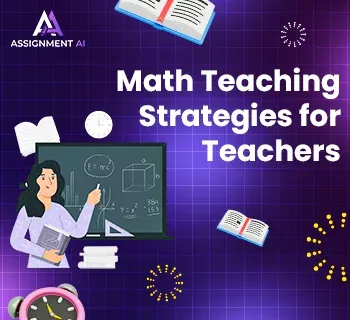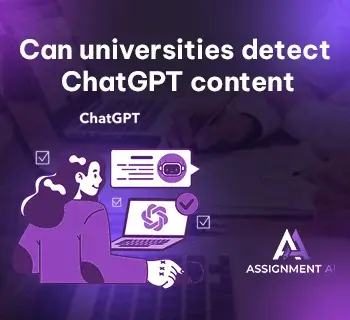AssignmentGPT Blogs
Picture a classroom from the viewpoint of a teacher. Quite different from the normal view that we’ve always had, right? With education evolving from rote learning to actual realization of concepts and fundamentals, teachers can definitely use an extra hand in the classroom. And by an extra hand, we mean Artificial Intelligence (AI) tools for teachers.
How does that run in a classroom? Well, let’s dive into it right away!
Quick Summary
Let’s break down what entails ahead. How does a medley between educators and AI tools in the classroom sound?
Ahead in this blog, you will come to know the need for teachers to start using AI tools in classrooms, and the different ways AI tools can help engage and enhance classroom learning.
We’ve also discussed about 7 different AI tools that you can employ for classroom learning, and the various ways they can contribute to enhanced learning for students.
Sound interesting? Without further ado, let’s get right into it!
Why Do Educators Need to Understand AI Tools?
Addressing the elephant in the room- Artificial Intelligence (AI). Do we really need AI empowered educators today? The answer is absolutely!
Educators already have a lot on their plate, even beyond the task of engaging a classroom with absolute gusto. A lot of the tasks that teachers usually perform are repetitive and time consuming. Take grading papers, for example, how many assignments do you think a teacher can grade in one go?
Imagine the amount of time that can be saved if tasks like grading and classroom management can be automated, or assisted with. This is why we need AI for teachers, so that education can be more of a fun experience than a monotonous routine.
How AI Can Improve A Teacher’s Job?
AI can find utility in almost every sphere today. Rest assured, the teachers will love to have a smart assistant in the classroom. As for the major ways AI can assist in classrooms, here are three:
- Personalized learning
One seemingly drawback regarding classroom education is the confidence invested in the “one-size-fits-all” approach. With the differences in learning capacity and interests among students, there is a need for personalized teaching for students.
AI tools can effectively help by identifying a student’s learning pace, their interests and design lesson plans that cater to individual students of varying mental strengths.
This also helps educators to assess and identify students needing extra help early on, so that they can be aided better.
- Productivity and efficiency
One aspect of using AI in a classroom is that as an educator, you can save a huge amount of time that would be otherwise wasted in repetitive tasks. This leads to improved productivity and a better focus for learner interactions.
Also, when you are leveraging AI in the classroom, you already know that efficiency is one mark that you aren’t missing. One of the ways you can do this is when providing feedback to learners. If AI can assess their learning curve, there’s definitely efficient feedback that can be provided for each learner.
- Creating and supplementing content
Suppose you are teaching about a crucial point in history. AI in the classroom can help generate content related to notes as well as quizzes related to the concepts.
This, inturn, can help educators to focus on learner interactions better, instead of creating quizzes and content related to subjects.
Also read this article : Best AI Tools for Teachers in 2024
How is AI used in Education?
There are various ways where AI is being already used in education, especially in classrooms. The table below contains a few of the tools that have found a comfortable desk in classrooms today.
| No | AI Uses In The Classroom | Tools That Can Be Used By Teachers |
|---|---|---|
| 1 | Classroom Management | Classcraft, ClassDojo |
| 2 | Automated Grading | Gradescope, ZipGrade |
| 3 | Personalized Learning | DreamBox, Smart Sparrow |
| 4 | Content Creation | Canva Magic Write, Slidesgo |
| 5 | Language Translation and Learning | Google Translate, Duolingo |
| 6 | Fact-Checking and AI Detection | AssignmentGPT AI Detector, Snopes, Turnitin |
| 7 | Interactive Learning | Kahoot!, Quizizz |
| 8 | Predictive Analytics | Educaid AI, IBM Watson |
7 Education Tools that Work
Cutting to the chase, it is easy to say AI needs to be integrated into classroom learning, but which tools should teachers go for? We’ve come up with a list of some very useful AI tools that can take classroom learning a leap higher.
1. AudioPen
AudioPen a device that converts the spoken language into written text-is a powerful shortcut to prepare lesson plans, lecture notes, or give feedback to students rather quickly.
You simply record your thoughts or discussions, and this device materializes as text before your eyes, saving you the hassle of taking notes and therefore a lot of time.

2. Canva Magic Write
The AI-powered writing assistant from Canva can enable teachers to build brilliant-looking content and presentations.
It is great for people that need to make lessons more dynamic, visually looking-when prepared templates and suggestions of designs according to your content are made.

3. CurriPod
With CurriPod, teachers can develop interactive lesson plans and activities led by AI. You type in what you want to teach your students, and it generates interactive slides with fun-filled activities that serve your purpose.
Pretty helpful for creating lessons that are both interactive and educational, keeping the students engaged with varied content!

4. Eduaide AI
Eduaide AI focuses on automating all administrative tasks and providing personalized learning resources along with generating tailored quizzes, assignments, and practice exercises based on concepts.
This might just be the all-in-one teaching assistant that our educators currently need.

5. OpenAI
OpenAI's models, such as ChatGPT, can support a wide range of activities in education: from brainstorming lesson ideas to content creation, even practice questions, not to mention real-time student support thanks to chatbots.
Well, it might just be time for teachers to start learning how to effectively use AI tools.

6. Quizizz
Quizizz is an online learning platform that applies the use of AI in constructing interactive quizzes and assessments. Teachers can build fun, gamified quizzes in many subjects that foster engagement and provide student feedback in real time.
This can be great for formative assessment: to measure student understanding in a fun way.

7. Slidesgo
If there’s one best AI for teacher lesson plans slides creation, this might be it!
Slidesgo has templates for presentations with AI that help educators build professional, visually-catching slideshows.

How Can Teachers Use AI in the Classroom?
If you’re still not sure how AI can start assisting educators in the classroom, here’s a detailed picture of the different facets you can be sure AI can be squeezed in to assist:

- Classroom Management
AI is a game-changer in managing classroom dynamics.
For example, AI-powered classroom management systems can analyze participation and engagement trends of students to provide richer insights that can help reach out to your students proactively.
Another scenario can be when students are detected off-task, or students are struggling, educators can intervene more effectively.
- Automated grading
Grading is perhaps the most time-consuming and repetitive duty a teacher undertakes. Consequently, AI was developed to lighten that burden from the teachers.
AI tools can easily grade multiple-choice questions, short answers, and even essays by analyzing responses and also providing feedback on the same.
- Personalized Learning
AI can be of great help if you are looking to pay individual attention to your learners. Adaptive learning platforms can use AI to analyze students' strengths and weaknesses and adjust, or tailor the learning resources to meet these requirements.
If a student, for instance, struggles with a particular concept or a subject, the AI tool can help with additional practice exercises or alternative explanations.
- Content Creation
If there is one thing that people know AI is already good at, it is creating content. AI-driven content creation software can develop quizzes, worksheets, and other interactive activities based on your learning objectives.
GenAI tools can also help brainstorm visually stimulating presentations and learning supports.
- Translation of Language and Learning
Many classrooms are exhibiting diverse student bodies with languages that differ. Here, AI-powered translation can bridge the gap in communication.
These tools offer translation of instructional materials and communications in multiple languages to make sure that all have access.
- Predictive analytics
Predictive analytics tools can enable teachers to locate students who may be at risk of falling behind or students who might require additional support. This is observed through patterns and learning trends of the students.
This helps to focus on learning issues from the start of the academic year, instead of after an ‘F’ on graded papers.
- Fact-Checking and AI Detection
Misinformation has welcomed fact-checking into the classroom.
In that line, AI can help detect AI-generated content to help instructors know if it is a student at work or probably something that has been automated. This will maintain the quality of student work and their academic integrity.
AssignmentGPT is one such tool that can help in this regard, with its strict flagging of AI content in academic work, thus ensuring academic integrity every point of the way.
Conclusion
With science fiction becoming real and at our fingertips, it is only the smart thing to do to integrate AI in learning curriculums, and classroom teachings.
From grading automation and classroom dynamics management to content creation and constructive, real-time feedback, AI tools have advantages that considerably enrich teaching and learning processes- benefiting both parties in a classroom.
This will gradually allow educators to invest more time and energy in inspiring and connecting with their students, while AI takes over the more mundane and repetitive aspects of teaching.
FAQs
1. How reliable are the grades provided by AI tools?
2. How do AI tools build engagement for the students in a classroom?
3. How efficient are AI tools in the classroom?
Content writer at @AssignmentGPT
Kandarp’s world is powered by conversations, content, and creativity. With experience across branding, literature, publishing, and strategy, he has helped shape identities and stories for businesses across industries. At AssignmentGPT AI, he leads a team that blends sharp content, strong design, and local insight to turn businesses into brands that connect with people.
Master AI with
AssignmentGPT!
Get exclusive access to insider AI stories, tips and tricks. Sign up to the newsletter and be in the know!

Transform Your Studies with the Power of AssignmentGPT
Empower your academic pursuits with tools to enhance your learning speed and optimize your productivity, enabling you to excel in your studies with greater ease.
Start Your Free Trial ➤Start your success story with Assignment GPT! 🌟 Let's soar! 🚀
Step into the future of writing with our AI-powered platform. Start your free trial today and revolutionize your productivity, saving over 20 hours weekly.
Try For FREE ➤








